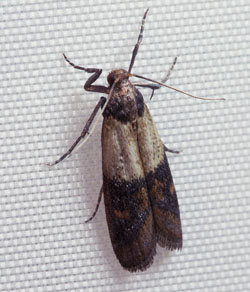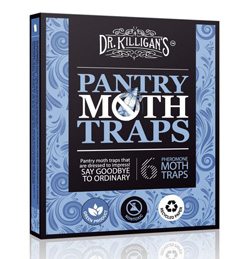
Pantry Moths and Pantry Moth Control
One of the most annoying pests to homeowners inside the house are Pantry Moths. Pantry Moths feed on stored food items.
Pantry Moths

The most common pantry moth found in homes is the Indian meal moth. Adult pantry moths are about 1/2 inch in length. They have a two-tone gray color.
Pantry moths have wings and are decent fliers. The first time you may know you have pantry moths is when you see them flying around.
If they are in your home, you may have accidentally brought them in along with some groceries you bought from the supermarket. This often happens.
Damage They Do
The moths in the one contaminated package of food can spread to other packages and ruin much of the food in the pantry. You have to get rid of them. These moths multiply in a hurry. Act fast!
Pantry Moth Control
First, find the contaminated package(s) and get rid of them. Look for other packages or food stuffs they might have gotten into and get rid of them also. Remove everything in the pantry and clean it thoroughly. Then put back the still good items. Some items, like flour or pasta, you may want to store in jars or bags in the freezer or refrigerator at least temporarily. That will keep them from getting into your so far pest-free items, and will kill any eggs that you don't see. You can also remove cereal and pasta from their packaging and store them in plastic or glass containers. Just be sure they have a good seal. These moths can get into a jar with a lid screwed on if it isn't tight enough.
HELPFUL HINTS: Check the following for cocoons and larvae: Packages of paper lunch bags, stored paper grocery bags, paper or cardboard containers like plastic wrap and aluminum foil, boxes of pasta, cereal. They will chew a hole in a cardboard or paper or even plastic bag to get to cake mixes, mixes in packets and pouches and non foodstuffs. They also feed on the glue that seals boxes. They often come in bird seed, dry dog and cat food and other small animal foods. They lay eggs in small cocoons in crevices and dark places like where the bottom of a shelf meets the supports, or behind a shelf where it meets the wall, or even under the shelf paper. To eliminate them completely, you must remove the shelf paper and start over. If you have a pantry closet, check the ceilings and corners of the walls for any small yellowish cocoons attached there. These things are tiny and masters of finding hiding places. If you just remove food items, you won't necessarily have won the war. They hide OUTSIDE of the food items as well.
Next, you have to make sure that any that were missed can't reproduce. You must disrupt the mating cycle.
Hang or place a pantry moth trap in the pantry. (Note: an example of a Dr. Killigan's Pantry Moth Trap, which is available from Amazon.com, is shown in the photo on the right.) These traps use a female pheromone scent to draw the males in, then they get stuck in glue and can't get out. No more breeding. You should check the trap to monitor your progress. If you find a moth has stuck in the glue, don't panic. It might have come from outside the pantry looking for a mate due to the trap. You caught him and he can't reproduce. However, if you find the trap is catching LOTS of moths, you probably haven't eliminated them completely. Don't give up. Check what you are bringing home from the grocery store. We once stopped shopping at a particular store when we realized we saw moths flying in the pet food and cake mixes/flour aisles! Just stay vigilant and you CAN and WILL eliminate them.


